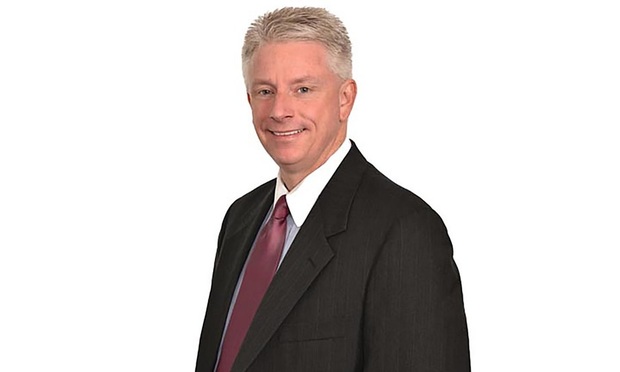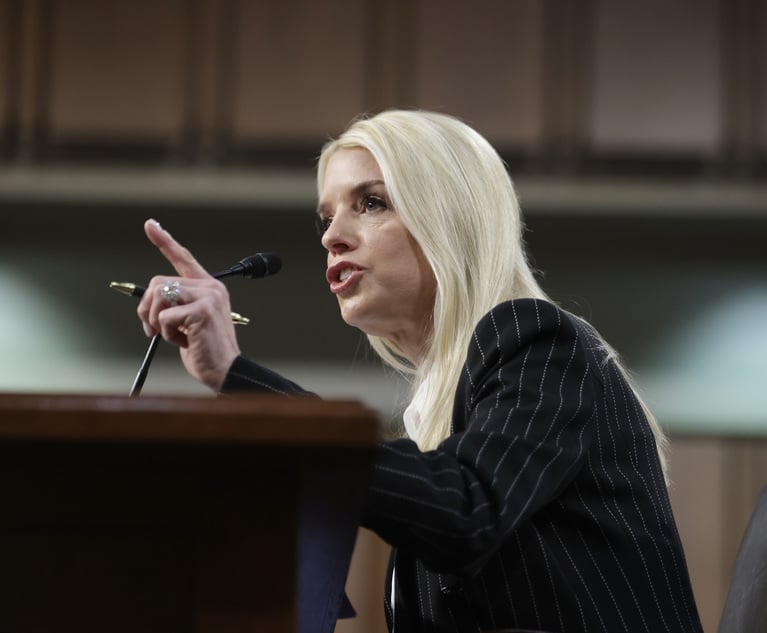The Hidden Dangers of Provisional Patent Applications and How to Avoid Them
Filing a provisional patent application was introduced into U.S. patent law in 1994. The ability to file a provisional application was widely applauded at the time and filing provisional applications remains extremely popular today. However, filing a provisional application can expose the inventor and the inventor's IP counsel to hidden dangers for the unwary.
October 01, 2019 at 12:34 PM
7 minute read
 James Kelly of Ratner Prestia.
James Kelly of Ratner Prestia.
Filing a provisional patent application was introduced into U.S. patent law in 1994. The ability to file a provisional application was widely applauded at the time and filing provisional applications remains extremely popular today. However, filing a provisional application can expose the inventor and the inventor's IP counsel to hidden dangers for the unwary.
Background
A regular, nonprovisional patent application must be filed with a formal specification, a set of claims and, in some cases, drawings. In addition to these formal requirements, a regular application is quite expensive to file, with the required initial government fees totaling about $2,000 (barring any discounts for the size of the filing entity).
A regular application issues as a patent when the U.S. Patent and Trademark Office (PTO) examines the application and determines that the specification and claims of the application meet all of the statutory requirements for a patent. The issued claims of the patent provide the inventor with the right to prevent others from making, using or selling the invention as defined by the claims.
In contrast, the requirements to file a provisional application are less strict. While the provisional application requires a written description of the invention and drawings if necessary to understand the invention, the description may be in almost any form because the provisional application is not substantively examined by the PTO. In fact, a set of hand-written notes describing the invention can be filed as a provisional application. A set of claims is not required. Significantly, the government fee for filing a provisional application is only $280—far less than the fees required for a regular application.
A provisional application cannot issue as a patent. In fact, as noted above, the provisional application is not substantively examined by the PTO for compliance with the statutory requirements for a patent. The inventor must still file a regular nonprovisional application within one year after the provisional application was filed, in order to obtain the benefit of the filing date of the provisional application.
Filing a provisional application can be advantageous.
The inventor can file a provisional application for a very low fee and then wait up to a year to see if the invention is worth expending the resources to file a regular application. The provisional application is simply a stake in the ground, an attempt to preempt and eliminate any "prior art" generated (whether by the inventor's own public disclosures or a competitor) between the filing date of the provisional and the later filed nonprovisional applications. If the inventor decides that the invention is not worth the investment, then provisional application can simply be allowed to go abandoned, and the provisional application will never publish (so neither the public at large nor competitors will ever learn of the invention).
Pitfalls
So, provisional applications are popular because they are easy, inexpensive to file, provide an early filing date for the invention, and allow the inventor to wait-and-see whether a patent makes commercial sense. What's not to love?
Unfortunately, here is a common scenario in which a provisional application is filed. An inventor contacts IP counsel very late in the day in a panic because the inventor is going to describe the invention during a presentation early the next morning, and requests that IP counsel file a patent application immediately. Since there is simply not enough time to prepare and file a regular patent application, IP counsel will typically file a provisional application on the same day. In this situation, IP counsel usually obtains a copy of the information the inventor is going to present and files this information as a provisional patent application with the PTO—which is completely acceptable.
This is where the trouble often begins.
After the provisional application is filed, it is standard practice for IP counsel to send the inventor a series of reminders that the regular nonprovisional application must be filed within one year. The inventor will often wait until very close to the due date to file the regular application—perhaps due to a combination of believing that the provisional application provides protection for the invention and not wanting to expend the resources to file the regular application, among other factors.
Then, IP counsel prepares and files the regular patent application, which includes a set of claims that define the invention. However, since the claims were only drafted at the time the regular application was prepared, it is quite possible that the provisional application—filed up to a year earlier—does not contain a description for some or, in the worst-case-scenario, all of the subject matter in the claims of the regular application.
In this situation, the effective filing date for any claim containing subject matter that was not described in the provisional application will be the filing date of the regular application—which may be up to a year later. When the PTO examines the claim for patentability over the art, there may be many more references that can be cited against the claims because the effective filing date of the claims is up to a year later than the filing date of the provisional application. This can be disastrous. The scope of the claims may have to be narrowed in order to be patentable over these references. In fact, these references may prevent any claims from being granted by the PTO.
How can IP counsel help inventors avoid these dangers of provisional applications?
The best practice is for IP counsel is to treat the preparation of a provisional application in the same way as regular nonprovisional application. Carefully review the invention disclosure documents, draft an initial application (i.e., specification claims and drawings), and then work with the inventor to prepare an application with claims of broad scope to protect the invention that are supported by an adequate description of the subject matter of the claims.
However, following this best practice is not always possible in the real world. When the provisional application must be filed at the last minute, like the scenario described above, there are several steps IP counsel can take to avoid the pitfalls of provisional applications.
IP counsel should review the invention and draft a set of claims to file with the provisional application along with an adequate description of the claimed subject matter in the application, if possible. This may provide at least some protection for the invention. Obviously, the more time and effort that IP counsel can put into drafting the claims to file as part of the provisional application, the higher the probability that the provisional application will provide support for the subject matter that is claimed in the later-filed regular nonprovisional application.
Immediately after the provisional application is filed, IP counsel should advise the inventor that the provisional application may not support claims of the broadest scope that the inventor may want to pursue in the regular application. Diligence is required to support broad (and commercially valuable) claims. IP counsel should advise the inventor that the regular application should be drafted immediately and not wait until one year after the provisional application was filed to prepare and file the regular application. This will ensure that the subject matter of the claims of the regular application receives an earlier filing date.
This maximizes the benefits of filing a provisional patent application—low costs and an early filing date—while minimizing the risks of the hidden dangers associated with provisional applications.
James Kelly, counsel in Ratner Prestia's Washington, D.C. office, is an intellectual property attorney with over 20 years of experience focusing on patent prosecution. His experience in United States and ex-U.S. patent prosecution along with conducting thousands of examiner interviews at the USPTO validates his profound technical and legal experience.
This content has been archived. It is available through our partners, LexisNexis® and Bloomberg Law.
To view this content, please continue to their sites.
Not a Lexis Subscriber?
Subscribe Now
Not a Bloomberg Law Subscriber?
Subscribe Now
NOT FOR REPRINT
© 2025 ALM Global, LLC, All Rights Reserved. Request academic re-use from www.copyright.com. All other uses, submit a request to [email protected]. For more information visit Asset & Logo Licensing.
You Might Like
View All
Lawyers' Phones Are Ringing: What Should Employers Do If ICE Raids Their Business?
6 minute read


3rd Circuit Strikes Down NLRB’s Monetary Remedies for Fired Starbucks Workers
Trending Stories
- 1Judge Sides With Retail Display Company in Patent Dispute Against Campbell Soup, Grocery Stores
- 2Is It Time for Large UK Law Firms to Begin Taking Private Equity Investment?
- 3Federal Judge Pauses Trump Funding Freeze as Democratic AGs Launch Defensive Measure
- 4Class Action Litigator Tapped to Lead Shook, Hardy & Bacon's Houston Office
- 5Arizona Supreme Court Presses Pause on KPMG's Bid to Deliver Legal Services
Who Got The Work
J. Brugh Lower of Gibbons has entered an appearance for industrial equipment supplier Devco Corporation in a pending trademark infringement lawsuit. The suit, accusing the defendant of selling knock-off Graco products, was filed Dec. 18 in New Jersey District Court by Rivkin Radler on behalf of Graco Inc. and Graco Minnesota. The case, assigned to U.S. District Judge Zahid N. Quraishi, is 3:24-cv-11294, Graco Inc. et al v. Devco Corporation.
Who Got The Work
Rebecca Maller-Stein and Kent A. Yalowitz of Arnold & Porter Kaye Scholer have entered their appearances for Hanaco Venture Capital and its executives, Lior Prosor and David Frankel, in a pending securities lawsuit. The action, filed on Dec. 24 in New York Southern District Court by Zell, Aron & Co. on behalf of Goldeneye Advisors, accuses the defendants of negligently and fraudulently managing the plaintiff's $1 million investment. The case, assigned to U.S. District Judge Vernon S. Broderick, is 1:24-cv-09918, Goldeneye Advisors, LLC v. Hanaco Venture Capital, Ltd. et al.
Who Got The Work
Attorneys from A&O Shearman has stepped in as defense counsel for Toronto-Dominion Bank and other defendants in a pending securities class action. The suit, filed Dec. 11 in New York Southern District Court by Bleichmar Fonti & Auld, accuses the defendants of concealing the bank's 'pervasive' deficiencies in regards to its compliance with the Bank Secrecy Act and the quality of its anti-money laundering controls. The case, assigned to U.S. District Judge Arun Subramanian, is 1:24-cv-09445, Gonzalez v. The Toronto-Dominion Bank et al.
Who Got The Work
Crown Castle International, a Pennsylvania company providing shared communications infrastructure, has turned to Luke D. Wolf of Gordon Rees Scully Mansukhani to fend off a pending breach-of-contract lawsuit. The court action, filed Nov. 25 in Michigan Eastern District Court by Hooper Hathaway PC on behalf of The Town Residences LLC, accuses Crown Castle of failing to transfer approximately $30,000 in utility payments from T-Mobile in breach of a roof-top lease and assignment agreement. The case, assigned to U.S. District Judge Susan K. Declercq, is 2:24-cv-13131, The Town Residences LLC v. T-Mobile US, Inc. et al.
Who Got The Work
Wilfred P. Coronato and Daniel M. Schwartz of McCarter & English have stepped in as defense counsel to Electrolux Home Products Inc. in a pending product liability lawsuit. The court action, filed Nov. 26 in New York Eastern District Court by Poulos Lopiccolo PC and Nagel Rice LLP on behalf of David Stern, alleges that the defendant's refrigerators’ drawers and shelving repeatedly break and fall apart within months after purchase. The case, assigned to U.S. District Judge Joan M. Azrack, is 2:24-cv-08204, Stern v. Electrolux Home Products, Inc.
Featured Firms
Law Offices of Gary Martin Hays & Associates, P.C.
(470) 294-1674
Law Offices of Mark E. Salomone
(857) 444-6468
Smith & Hassler
(713) 739-1250





